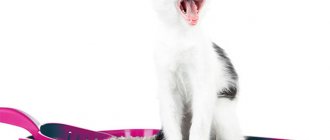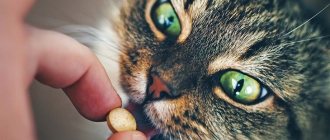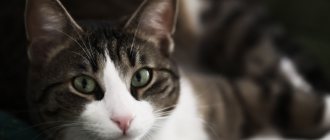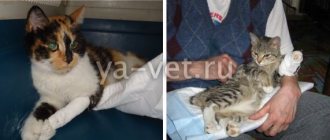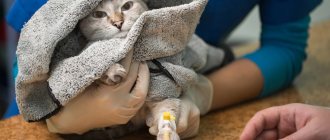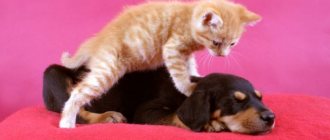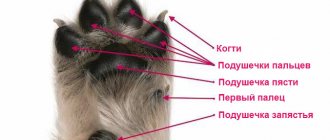Digestive tract disorders are common in pets, including cats. One of the most common manifestations of gastrointestinal disorders is constipation, which causes a lot of discomfort for animals and can lead to serious health consequences. Pathology can be treated with medications or simple home methods - folk recipes, proper nutrition, massage. They are no less effective than laxatives and are safer for your pet’s health. How to massage a cat with constipation, and what do animal owners need to know about this procedure?
How to massage a cat with constipation
General Information about Constipation in Cats
Constipation is a pathology in which there is difficulty in passing stool out or its complete absence. Causes that can cause constipation in cats include:
- errors in nutrition (unbalanced diet, natural food, a large number of fatty foods on the menu, etc.);
- inflammatory, infectious and tumor processes in the intestines;
- neurological disorders;
- lack of physical activity;
- disorders of kidney and liver function;
- prostatitis in males;
- narrowing of the anus;
- entry of a foreign body or hairball;
- diseases of the musculoskeletal system;
- perineal hernia;
- surgical interventions - for example, castration or sterilization;
- intestinal obstruction;
- age-related changes in the body, accompanied by a decrease in intestinal motility;
- worm infections;
- abdominal trauma;
- taking medications.
The main symptom of constipation is the absence of bowel movements or rare (every 3-4 days) trips to the toilet. Cats suffering from constipation become lethargic, do not want to eat or play, and may experience nausea, vomiting, and bloating. The pet may make attempts to relieve itself, but they are painful, and, as a rule, end in failure - feces come out in small quantities, look dry and hard, or do not come out at all.
Constipation causes serious discomfort for animals and leads to intoxication.
The absence of normal bowel movements for three days or more is an extremely dangerous condition that can lead to intoxication of the body and serious complications.
Attention! Constipation is not an independent disease, but a symptom of various pathologies, therefore, in order to completely eliminate problems with bowel movements, you must first get rid of their cause.
What to give your cat for constipation
Duphalac is one of the laxatives that are allowed for cats.
The most effective method of treating constipation is the use of medications that have a laxative effect, but it cannot be considered absolutely safe. Such drugs cause side effects, and in some cases can be dangerous to the health of animals, so they should be used after consultation with a veterinarian.
Table 1. Constipation remedies for cats.
| Constipation remedy | Features of application |
| Linseed oil | 0.5 ml of oil orally every 1-2 hours until the condition improves (as a rule, after the second or third dose, normal bowel movements occur) |
| Vaseline oil | |
| Vaseline based candles | Divide the candle into 2 parts, and, holding the animal in place, insert it into the anus, then press the tail and fix it in this position for 5-10 minutes. |
| Preparations based on lactulose (Duphalac, Lactusan) | The dosage is calculated based on the following formula: 0.5 ml of the drug per kilogram of the pet’s weight, the frequency of administration is 2-3 times a day, use the drug before the onset of defecation and for one day after it to prevent relapse |
The following medicinal plants are used as folk remedies to relieve constipation in cats:
- aloe;
- chamomile;
- mint;
- celandine;
- borage;
- rhubarb leaves.
They can be given in their natural form or prepared as decoctions and infusions, which should be given to the pet little by little.
Camomile tea
Another effective remedy for constipation is an enema, for which you will need a special syringe for cats or a syringe. To cure a mild defecation disorder, 50-75 ml of warm boiled water is enough, and for a better effect you can add a little Vaseline oil. The pet is wrapped in a towel or blanket, liquid is injected into the rectum, after which relief should occur.
Enema is an effective remedy for constipation in cats
It is impossible to use “human” laxatives (except for those that are not prohibited by veterinarians), or to give cats with constipation other vegetable oils - they can negatively affect the functioning of the kidneys and liver.
Important! For chronic constipation and defecation disorders caused by mechanical blockage of the intestines, laxatives, enemas and folk remedies cannot be used - such conditions require medical intervention.
Enema for a cat
Prevention at home
A kitten's eyes are festering: how to treat it at home
To prevent the development of intestinal obstruction in kittens, you must adhere to the following rules:
- proper nutrition, which includes avoiding excessive consumption of dry food. It is preferable to give your pet wet food, as well as homemade products;
- consumption of fiber. This component is found in flax seeds, ground plantain leaves and bran;
- it is necessary to monitor the condition of the animal and begin treatment at the first symptoms of the disease;
- balanced meals should be at least 2 times a day. It is important to provide your pet with drinking water;
- periodically carry out preventive measures against worms and other intestinal parasites. For this purpose, the cat is given special tablets or drops;
- Provide your kitten with an active lifestyle. The pet must have space to play, as well as various exercise equipment for climbing to heights;
- The pet must be combed of excess hair, and also given cleansing phytomins.
A healthy cat will thank you with affection
When you bring home a small pet, you should be prepared that it requires care like a real child. He also needs the right diet, protection and warmth from the owner. Constipation is one of the most common problems that needs to be dealt with as quickly as possible.
How to massage a cat
Veterinarians often recommend massage to both healthy and sick cats as a relaxing and therapeutic procedure for various diseases, including disorders of the gastrointestinal tract. It improves the general condition of the animal, relieves muscle tension, improves immunity, activates the digestive tract and establishes a closer and more subtle connection between the pet and the owner. The main thing is to carry out the procedure correctly, taking into account all the features and contraindications of the procedure.
Massage is recommended for cats as a relaxing or therapeutic procedure.
In what cases is massage prohibited?
You can perform a massage only in cases where the general condition of the animal does not cause concern, and also take into account absolute contraindications to the procedure, which include:
- dermatological diseases, skin lesions (injuries, burns, etc.);
- acute conditions, including high fever, dehydration, poisoning, exhaustion;
- inflammatory diseases of internal organs, pathologies of bones and musculoskeletal system;
- exhaustion of the body;
- pregnancy.
Kittens and older animals can be given a light massage, but it is better to consult a veterinarian first. Babies can begin to be massaged just a few weeks after birth - they will be quite ready for this procedure, since in the first days of life it is performed by the cat herself using her tongue. By licking the offspring, the cat not only performs hygiene procedures, but also activates metabolic processes and intestinal function. When performing manipulations, special care should be taken not to injure the pet with awkward or too intense movements.
Before performing a massage, you should take into account all contraindications.
When is massage harmful?
There are some contraindications for cat massage:
- Vomiting, dehydration, high temperature (more than 39.5 degrees) are a sign that constipation is a symptom of another serious disease. You need to see a doctor.
- If there are areas of skin with damage.
- Diseases of internal organs.
- Hernias, intestinal tumors. Mechanical impact can cause the tumor to increase in size and even transform into cancer.
- Intestinal volvulus.
- Blockage of the intestines by a foreign object.
- You cannot massage cats on your own during pregnancy.
- Cats that have undergone abdominal surgery, including cesarean section or sterilization, should not undergo massage for six months.
In these cases, the effect on the peritoneum will not have a therapeutic effect, but can only aggravate the situation.
Massage for constipation: possible or not
Massage helps well with mild constipation, which is caused by defecation disorders due to errors in nutrition, a tendency to flatulence and other digestive tract disorders associated with deterioration of intestinal motility (especially if the animal constantly has to take laxatives). There are a few more situations when massage is contraindicated - these include diseases and pathological conditions that require medical intervention, and sometimes surgical treatment.
- Constipation accompanied by alarming signs. Symptoms to watch for include fever or hypothermia, vomiting, dehydration, intense abdominal pain (if your cat is constantly screaming or rocking on the floor), and severe bloating.
- Suspicion of neoplasms. Any mechanical impact in case of tumor diseases is strictly prohibited, even if the neoplasm is benign - the tumor can begin to bleed, increase in size and transform into cancer.
- Inflammatory bowel diseases. For colitis, gastritis and other inflammatory diseases, the animal requires complex diagnosis and treatment, and home treatment methods can provoke serious complications.
- Blockage of the intestine by a foreign body. Bone fragments are especially dangerous for the health and life of a cat - they can puncture the intestinal wall, as a result of which the animal will die from painful shock or internal hemorrhage.
- Spasms of the large intestine. Spastic contractions of the large intestine in combination with massage threaten the pet with intestinal rupture with all the ensuing consequences.
- Fractures of the pelvic bones. If a cat has had pelvic bone fractures at least once in its life, an x-ray must be taken before performing a massage - perhaps constipation is caused by adhesive disease or improper fusion of bones.
- History of abdominal surgery. For animals that underwent abdominal surgery, including cesarean section, less than six months ago, mechanical impact on the abdominal cavity is contraindicated.
Massage for such diseases will not bring the desired effect, will cause pain to the animal, and can significantly worsen the condition and cause death.
At a temperature, massage is contraindicated
Carefully! Massage is very useful for cats that have recently given birth - it promotes rapid recovery of the body, prevents mastitis and other diseases, but before carrying out the procedure, you should make sure that the animal’s condition is satisfactory and there are no signs of postpartum complications.
Causes of constipation
The most common cause, depending on the owner, is an unbalanced diet. For normal digestion and bowel movements, the cat must receive foods with hard fibers. Inexperienced owners often believe that if they feed their pet only meat, it will be healthier. In fact, exclusively protein foods quickly lead to stagnation in the intestines.
Cats are nocturnal hunters, feeding in the wild only on what they catch. The cat eats its prey along with its fur, intestines and its contents. With a natural diet, the ratio of protein to fiber is approximately 10:1–10:2.
Important! If a cat receives an unbalanced diet, in which carbohydrate foods predominate over protein foods, it may also develop constipation.
Constipation can occur due to blockage of the small or large intestine. Due to the cat's curiosity, it may eat something inedible , for example, a piece of rope, Christmas tree decorations, wrapping paper or cellophane. An equally common cause of constipation is excess weight. If an animal is obese, metabolic processes are disrupted, which can lead to the formation of dry feces.
Massage technique
The procedure must be carried out at least two hours after eating, and it is necessary to choose a time when the cat is calm and not busy with important things (sleeping, playing, licking itself, etc.). It is better to start with light scratching or stroking, and then move on to more intense manipulations. If the animal is worried or tries to run away, there is no need to restrain it by force - it is better to interrupt the massage and repeat it after 30-40 minutes.
Relaxation massage technique
There is no universal massage technique - during the procedure you need to monitor the cat’s reaction and adjust your actions depending on its behavior.
- All movements are performed with the palm of one or both hands - a massage done with the fingertips will be too weak and may cause discomfort.
- The massage should be performed in the direction from the middle of the body to the limbs.
- It's best to start with the neck, lightly moving your fingers through it and not applying too much force.
- Next, you should move to the upper part of the body - work the shoulders and front legs in a circular motion, and then massage the back to the hips in the same way.
- Massage of the thighs should be very careful, using stroking movements, as they are one of the most sensitive places in cats.
- The tail can only be massaged if the cat does not twitch it, moving from the tip to the hips.
- Lastly, they work on the head - first the crown, then the areas around the ears and temples.
- At the end of the procedure, you should confidently, but without strong pressure, run your palm several times over the entire body of the pet.
The average length of a relaxation massage is 10-15 minutes, with approximately the same amount of time spent on each area.
In the absence of contraindications, massage can be performed even on kittens.
Important! Active resistance during a massage can be caused by pain in one or another part of the body - in this case, you need to find out which manipulations cause discomfort, and then show the animal to a veterinarian.
Video – Cat massage
Massage technique for constipation
It is better to start abdominal massage after a few days of relaxing massage, when the cat gets used to the procedure and begins to completely relax during it. The algorithm of actions is as follows:
- stroke the upper abdomen two or three times;
- circling your hand around the midline of the abdomen, then gently descending towards the groin area;
- use light circular movements to treat the entire abdomen;
- Use gentle kneading movements along the abdomen, starting from the edge of the ribs to the upper thighs;
- place your palm on the lower abdomen and stretch it three times to the top, without lifting it from the surface of the skin - you should act carefully, but quite actively;
- repeat the previous two points one by one;
- stroke the stomach from left to right, starting from its upper part and going down;
- complete the procedure with light pats.
If you have constipation, you need to massage the belly of a cat regularly, preferably twice a day - if you carry out the procedure occasionally, you will not have the desired effect. In addition, you need to review your pet’s diet, introduce fermented milk products, boiled and grated vegetables and cereals, and also make sure that the animal receives enough fluid.
When performing a massage, the cat should be completely relaxed
Recommendations for the procedure
To massage a cat with constipation without harm to health and with minimal stress, you need to follow these rules:
- The procedure is carried out only 2 hours after eating. Mechanical impact on a full stomach will worsen the situation.
- During the massage, they talk to the cat in a gentle voice. Then she will feel that everything is okay and will not be afraid.
- If the pet resists and persuasion does not work, it is better to let it go. Let him rest for 1-2 hours, after which you can try again.
- If the cat still tries to escape, it is most likely in pain. It is better not to experiment and contact a veterinarian.
- You should not start a massage if a person has cold hands. Touching will be extremely unpleasant for the cat.
- There is no need to use any creams or oils as in the case of humans.
- The abdomen is massaged gently, without strong pressure.
On average, a cat should be given a massage for constipation for 15 minutes.
How to find out if massage has an effect
If, during a massage, gurgling or rumbling is heard in the cat’s stomach, it means that intestinal motility is improving, and the effect of the procedure will be noticeable in a few days - bowel function and bowel movements will return to normal. If there are no results or the pet’s condition worsens, you should consult a doctor as soon as possible to avoid complications and unpleasant health consequences.
If the massage is performed correctly, the cat's bowel movements should improve within a few days.
Regular massage is not only useful, but also a pleasant procedure that the animal will really like. There are no special difficulties or secrets in carrying out the procedure - you just need to perform it regularly, carefully and with love.
